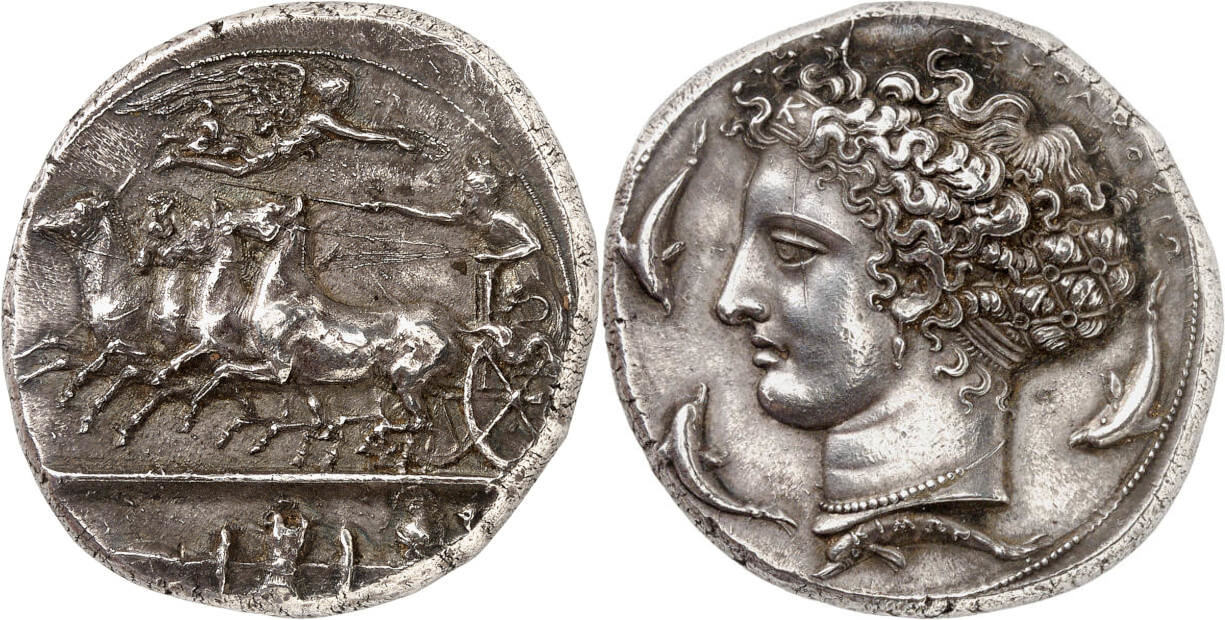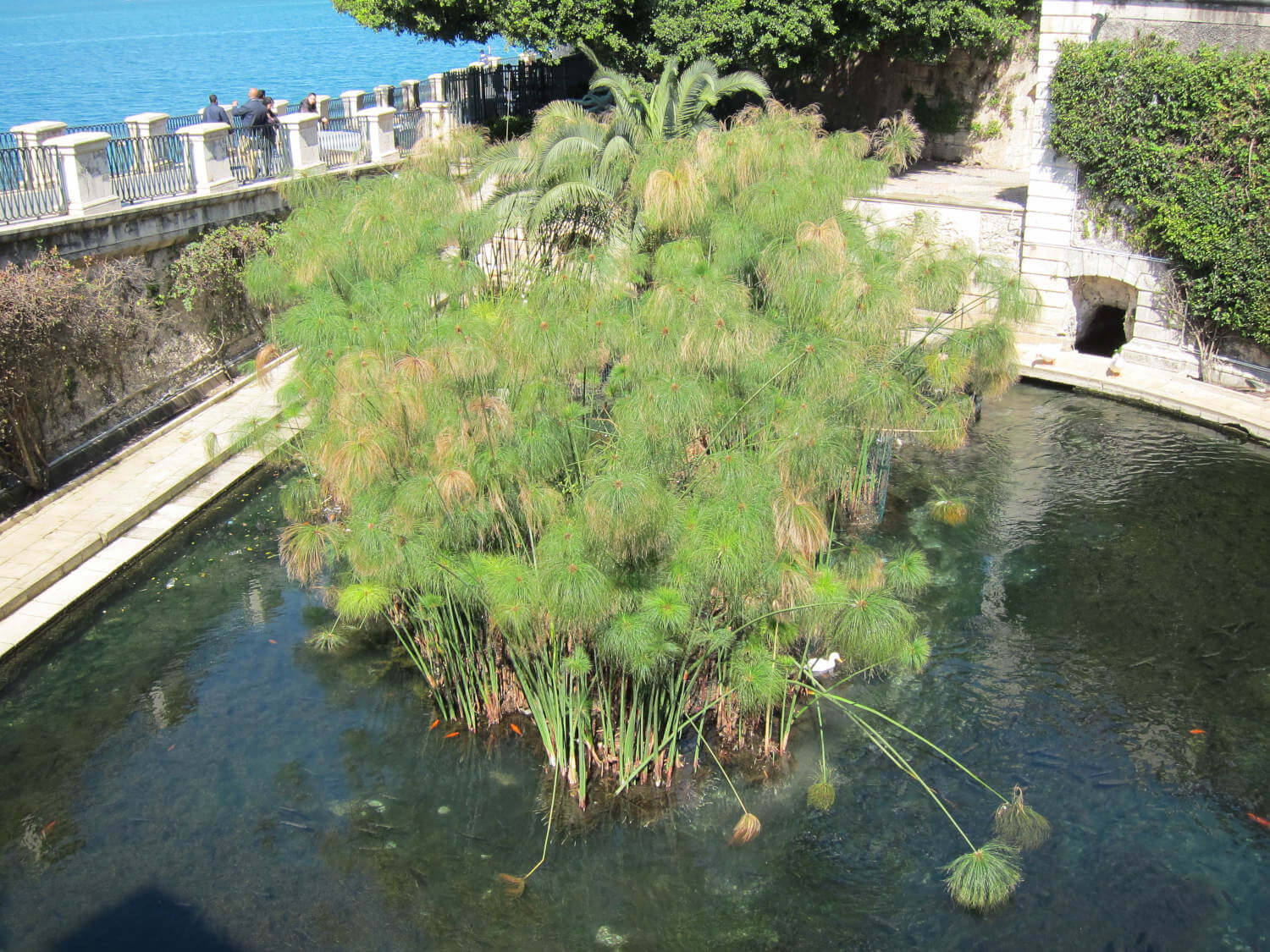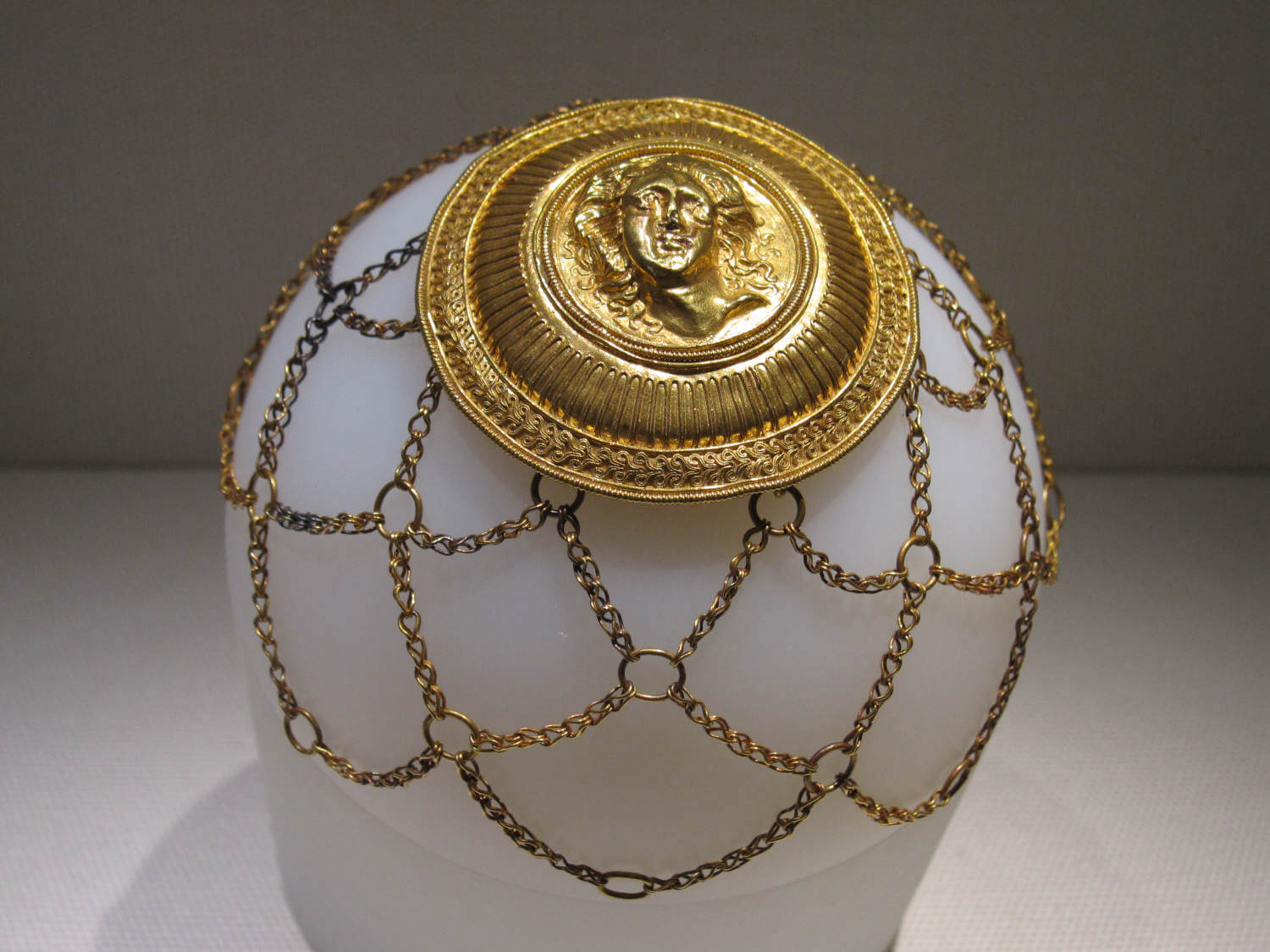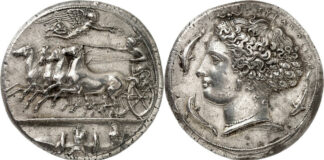For centuries, archaeologists, art connoisseurs and aesthetes alike have extolled the beauty of Syracusan coinage in the era of the signing artists. These coins are praised as the peak of all Greek numismatics; in fact, they are said to be more beautiful than any other coin made to this day. In any debate on which coins from this short period are the most significant, you’ll always hear the names of the two incomparable die cutters Kimon and Euainetos. And Kimon’s name will always be mentioned first. He is considered the greatest artist ever to have made a coin, having created designs that have been imitated for over two and a half millennia. When he designed his Arethusa, with her long, curly hair gathered into a hairnet, he created one of the central archetypes of numismatics.
On 14 November 2022, as part of its auction 16, Numismatica Genevensis will be able to offer the two most beautiful decadrachms struck from the unparalleled dies designed and engraved by Kimon. Their provenance dates back to 1940 and 1941 respectively. And they are the two best-preserved specimens of this coin type in existence. They are fully struck and fully centred, with a beautiful patina. Even the outstanding photos in the catalogue don’t quite do justice to the beauty of these pieces. They are eminent works of ancient art that have shaped our concept of aesthetics.
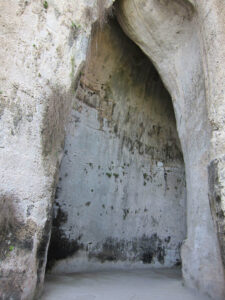
The History Behind the Coins
Thanks primarily to hoard evidence, we now know that the decadrachms were not minted as a sort of commemorative coin to mark the Syracusan victory over the Athenians in 413 BC, but were actually produced nearly a decade later. They date back to the time Dionysius I seized power, a triumph he owed to the Carthaginian invasion of 406 to 405 BC.
His rise to power was set in motion by the fact that, after the Athenians had been defeated, there was still a dispute simmering between their ally, the city of Segesta, and Selinus, which was allied with Syracuse. It was probably in 410 BC that Segesta requested support from Carthage, which probably sent an impressive force to Sicily that same year. The Carthaginians conquered Selinus in either 409 or 408 BC, followed by Himera.
And that might have been the end of the conflict for the time being if the Syracusan general Hermocrates hadn’t moved into Selinus on his own account, with the support of mercenaries and refugees from Himera, to settle there. His raids on the territory of Motya and Panormos made the Carthaginians so angry that they decided to resume the war against Syracuse, even though Hermocrates himself died in 407 BC.
The Carthaginians’ attack on Akragas in the spring of 406 BC was countered by an alliance hastily forged between the cities of Syracuse, Gela, Camarina and Messene. This alliance also had the support of Campanian mercenaries. These combined forces were once again victorious at the Himera River, but when the mercenaries swapped sides in exchange for 15 talents in the autumn of 406 BC, Akragas had to be surrendered to the Carthaginians.
This bitter defeat generated the support Dionysius needed to get himself elected as Strategos Autokrator, i.e. the sole commander-in-chief of Syracuse, in the spring of 405 BC. This transfer of power was not a very smooth process. In the early summer of 405 BC, the Carthaginians destroyed Akragas, forcing Dionysius to evacuate Gela. This triggered an uprising against him, which he just managed to quell before the Carthaginians started besieging Syracuse. Dionysius was saved by the outbreak of a plague, which enabled him to conclude a favorable peace agreement with the Carthaginians. In this agreement, Sicily was divided into the Carthaginian eparchy in the west and the Greek territories in the east. At the same time, the Carthaginians recognized Dionysius as the ruler of Syracuse.
The period that followed was by no means peaceful: Dionysius consolidated his power with a series of military campaigns, during which Naxos and Catane came under his control. At the same time, he also prepared a raid on the Carthaginian eparchy. His second war against the Carthaginians began in the year 398 BC.
The two wonderful decadrachms presented by Numismatica Genevensis were probably made during the period between Dionysius’ takeover of power and his raid on the Carthaginian eparchy. They were not a product of peace, but rather created as part of the preparations for war.
The Coin Motifs: A Quadriga and the Fountain Nymph of Syracuse
Syracuse stuck with the same coin motifs for centuries. The obverse of the city’s tetradrachms and decadrachms depicts a victorious quadriga (a chariot drawn by four horses). The Gamaroi – the wealthy noble families of the city – regularly sent teams and athletes to the Olympic Games. The close connection between Syracuse and Olympia is very well attested. Archaeologists have found remnants of the Syracusan treasury built by the architect Pothaeus in Olympia. And the lists of Olympic victors prove that many Olympic athletes came from Syracuse.
Perhaps that’s why a central element of the coin design is Nike, the goddess of victory, who is crowning the charioteer – or the horses, on some other coins. This design is not alluding to any particular victory. The die cutters intended to present the inherent victoriousness of Syracusans as a sign of divine favor. Their triumphs at Olympia proved that the city had Zeus’ support, which was also expected to manifest in the form of military victories. Perhaps that’s why the decadrachms depict a hoplite’s equipment (armor, greaves and a helmet) below the victorious chariot.
The reverse is dominated by Arethusa, that unique symbol of divine favour, which the Syracusans worshipped with cultish devotion. After all, the freshwater fountain on the island of Ortygia, surrounded by the sea, was of crucial military importance: a fortress with an abundant supply of fresh water is difficult to conquer, something that both the Carthaginians and the Romans had to learn. The safe havens on Ortygia are reflected in the dolphins surrounding the head of the nymph on the coin, just as – in reality – the sea surrounded the island of Ortygia with its Arethusa fountain.
Both the quadriga and Arethusa herself were adapted over the course of Syracusan coinage to suit the beauty standards of the Syracusan citizens. Arethusa, in particular, changed from an archaic-classical beauty ideal into an almost portrait-like figure. The die cutter Kimon, about whom we know very little except that he was active from around 415 to 390 BC, struck a perfect balance between vivid beauty and stylization, making his portraits the incarnation of Greek artistry.
It is rather significant that he signed his dies (or that he was allowed to do so), and often more than once. His signature appears at the ground line on the obverse, on the band holding Arethusa’s hairnet and on one of the four dolphins.
The Afterlife of Kimon’s Decadrachms
Even back in ancient times, Kimon’s decadrachms were considered masterpieces, with countless die cutters attempting to imitate them. Since the Renaissance, Kimon’s decadrachms have been regarded as a unique masterpiece, the most beautiful pieces that Greek coinage has to offer. Johann Joachim Winckelmann, the father of classical archaeology, marveled at the “unparalleled beauty” of the Sicilian coins. The English poet Yeats praised them as the “most famous and beautiful” of all coins.
And the French poet José-Maria de Heredia, who ran what was probably the most famous literary salon in Paris around 1900, wrote a poem about them:
Le temps passe. Tout meurt. Le marbre même s’use.
Agrigente n’est plus qu’un ombre, Syracuse
Dort sous le bleu linceul de son ciel indulgent;
Et seul le dur métal que l’amour fit docile
Garde encore en sa fleur, aux médailles d’argent
L’immortelle beauté des vierges de Sicile.
Time goes by. All things die. Even marble decays.
Akragas is no more than a shadow, and Syracuse
Sleeps, still in death, beneath her kind sky’s shades;
And only the hard metal preserves, through all the days,
Silver grown docile unto love’s own use,
The immortal beauty of Sicilian maids.
Literature: Wolfgang Fischer-Bossert, Coins, Artists, And Tyrants: Syracuse in the Time of the Peloponnesian War. ANS Numismatic Studies 33 (2017).
For more details on the decadrachms of Kimon and the auction, see the Numismatica Genevensis SA catalog.
For more information, visit the auction house website.
According to Alain Baron and Philippe Veuve, a coin of Kimon is one of the most beautiful coins featuring of women.
In the “Sicilian Mosaic” series, Ursula Kampmann explains the classical coinage of Syracuse – including the coins of Kimon.
Of course, decadrachms of Kimon can also be found in the world-famous Numismatic Museum in Athens.






